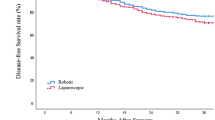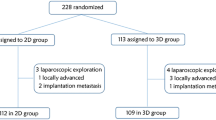Abstract
Background
Numerous studies have shown that the short-term efficacy of three-dimensional (3D) laparoscopic radical gastrectomy (LG) is comparable to that of two-dimensional (2D)-LG. Whether 3D-LG affects the recurrence patterns of gastric cancer (GC) patients has not been investigated.
Methods
From January 2015 to April 2016, a total of 419 patients were recruited for a phase III clinical trial (NCT02327481), which compared the short-term outcomes between the 2D and 3D groups. The long-term efficacy including recurrence patterns was compared between the 2D and 3D groups in this retrospective study. Multivariate analyses were performed to determine whether 3D-LG affects the recurrence patterns.
Results
Ultimately, 401 patients were analyzed (197 in the 2D-LG group and 204 in the 3D-LG group), and no differences were observed in the clinicopathological data between the two groups. There were no significant differences between the two groups in the recurrence types, first recurrence time or recurrence-free survival (RFS) (all p > 0.05). According to the 7th American Joint Committee on Cancer tumor-node-metastasis (TNM) staging system, both groups were stratified into pathological stages I, II, and III. The stratified analysis showed no significant differences in RFS or overall survival (OS) among patients in each subgroup (all p > 0.05). The multivariate analysis of RFS showed that tumor diameter, pTNM stage, lymphovascular invasion, and adjuvant chemotherapy were independent factors (all p < 0.05). The multivariate analysis of post-recurrence survival (PRS) showed that adjuvant chemotherapy was an independent protective factor (p = 0.043).
Conclusions
3D-LG for GC did not differ significantly from 2D-LG in the effects on 3-year recurrence patterns, RFS and OS, which provides more tumor-related evidence for 3D technology. And due to the technological similarity, it may have certain reference value for robotic-assisted gastrectomy. Further multicenter, large-scale clinical trials are warranted.


Similar content being viewed by others
References
Kitano S, Iso Y, Moriyama M et al (1994) Laparoscopy-assisted Billroth I gastrectomy. Surg Laparosc Endosc 4(2):146–148
Kitano S, Shiraishi N, Uyama I et al (2007) A multicenter study on oncologic outcome of laparoscopic gastrectomy for early cancer in Japan. Ann Surg 245(1):68–72
Kawamura H, Okada K, Isizu H et al (2008) Laparoscopic gastrectomy for early gastric cancer targeting as a less invasive procedure. Surg Endosc 22(1):81–85
Katai H, Mizusawa J, Katayama H et al (2016) Short-term surgical outcomes from a phase III study of laparoscopy-assisted versus open distal gastrectomy with nodal dissection for clinical stage IA/IB gastric cancer: Japan Clinical Oncology Group Study JCOG0912. Gastric Cancer 20(4):699–708
Hu Y, Huang C, Sun Y et al (2016) Morbidity and mortality of laparoscopic versus open D2 Distal gastrectomy for advanced gastric cancer: a randomized controlled trial. J Clin Oncol 34(12):1350–1357
Lee JH, Han HS, Lee JH (2005) A prospective randomized study comparing open vs laparoscopy-assisted distal gastrectomy in early gastric cancer: early results. Surg Endosc 19(2):168–173
Hayashi H, Ochiai T, Shimada H et al (2005) Prospective randomized study of open versus laparoscopy-assisted distal gastrectomy with extraperigastric lymph node dissection for early gastric cancer. Surg Endosc 19(9):1172–1176
Storz P, Buess GF, Kunert W et al (2011) 3D HD versus 2D HD: surgical task efficiency in standardised phantom tasks. Surg Endosc 26(5):1454–1460
Chiu CJ, Lobo Prabhu K, Tan-Tam CC et al (2015) Using three-dimensional laparoscopy as a novel training tool for novice trainees compared with two-dimensional laparoscopy. Am J Surg 209(5):824–827 (e1; discussion 827)
Blavier A, Gaudissart Q, Cadiere GB et al (2007) Comparison of learning curves and skill transfer between classical and robotic laparoscopy according to the viewing conditions: implications for training. Am J Surg 194(1):115–121
Aykan S, Singhal P, Nguyen DP et al (2014) Perioperative, pathologic, and early continence outcomes comparing three-dimensional and two-dimensional display systems for laparoscopic radical prostatectomy–a retrospective, single-surgeon study. J Endourol 28(5):539–543
Ohuchida K, Kenmotsu H, Yamamoto A et al (2009) The effect of CyberDome, a novel 3-dimensional dome-shaped display system, on laparoscopic procedures. Int J Comput Assist Radiol Surg 4(2):125–132
Agrusa A, di Buono G, Chianetta D et al (2016) Three-dimensional (3D) versus two-dimensional (2D) laparoscopic adrenalectomy: a case-control study. Int J Surg 28(Suppl 1):S114–S117
Zheng CH, Lu J, Zheng HL et al (2018) Comparison of 3D laparoscopic gastrectomy with a 2D procedure for gastric cancer: a phase 3 randomized controlled trial. Surgery 163(2):300–304
Lu J, Zheng CH, Zheng HL et al (2017) Randomized, controlled trial comparing clinical outcomes of 3D and 2D laparoscopic surgery for gastric cancer: an interim report. Surg Endosc 31(7):2939–2945
Lu J, Xu BB, Zheng ZF et al (2019) CRP/prealbumin, a novel inflammatory index for predicting recurrence after radical resection in gastric cancer patients: post hoc analysis of a randomized phase III trial. Gastric Cancer 22(3):536–545
Xu BB, Lu J, Zheng ZF et al (2019) The predictive value of the preoperative C-reactive protein-albumin ratio for early recurrence and chemotherapy benefit in patients with gastric cancer after radical gastrectomy: using randomized phase III trial data. Gastric Cancer 22(5):1016–1028
Washington K (2010) 7th edition of the AJCC cancer staging manual: stomach. Ann Surg Oncol 17(12):3077–3079
Sano T, Aiko T (2011) New Japanese classifications and treatment guidelines for gastric cancer: revision concepts and major revised points. Gastric Cancer 14(2):97–100
Lu J, Xu Y, Wu Y et al (2019) Tumor-infiltrating CD8+ T cells combined with tumor-associated CD68+ macrophages predict postoperative prognosis and adjuvant chemotherapy benefit in resected gastric cancer. BMC Cancer 19(1):920
Lee JH, Chang KK, Yoon C et al (2018) Lauren histologic type is the most important factor associated with pattern of recurrence following resection of gastric adenocarcinoma. Ann Surg 267(1):105–113
Lee D, Son SY, Kim YB et al (2018) Neural invasion is a significant contributor to peritoneal recurrence in signet ring cell gastric carcinoma. Ann Surg Oncol 25:1167–1175
Jin LX, Moses LE, Squires MH 3rd et al (2015) Factors associated with recurrence and survival in lymph node-negative gastric adenocarcinoma: A 7-institution study of the US gastric cancer collaborative. Ann Surg 262(6):999–1005
Xu BB, Lu J, Zheng ZF et al (2019) Comparison of short-term and long-term efficacy of laparoscopic and open gastrectomy in high-risk patients with gastric cancer: a propensity score-matching analysis. Surg Endosc 33(1):58–70
Fock KM (2014) Review article: the epidemiology and prevention of gastric cancer. Aliment Pharmacol Ther 40(3):250–260
Buess G, Theiss R, Günther M et al (1985) Endoscopic surgery in the rectum. Endoscopy 17(1):31–35
Herron DM, Lantis JC 2nd, Maykel J et al (1999) The 3-D monitor and head-mounted display. A quantitative evaluation of advanced laparoscopic viewing technologies. Surg Endosc 13(8):751–755
Game X, Binhazzaa M, Soulie M et al (2017) Three-dimensional laparoscopy for living-donor nephrectomy with vaginal extraction: the first case. Int J Surg Case Rep 34:87–89
Tang FJ, Qi L, Jiang HC et al (2016) Comparison of the clinical effectiveness of 3D and 2D imaging systems for laparoscopic radical cystectomy with pelvic lymph node dissection. J Int Med Res 44(3):613–619
Kinoshita H, Nakagawa K, Usui Y et al (2015) High-definition resolution three-dimensional imaging systems in laparoscopic radical prostatectomy: randomized comparative study with high-definition resolution two-dimensional systems. Surg Endosc 29(8):2203–2209
Velayutham V, Fuks D, Nomi T et al (2015) 3D visualization reduces operating time when compared to high-definition 2D in laparoscopic liver resection: a case-matched study. Surg Endosc 30(1):147–153
Chang JS, Kim KH, Yoon HI et al (2017) Locoregional relapse after gastrectomy with D2 lymphadenectomy for gastric cancer. Br J Surg 104(7):877–884
Takahashi Y, Takeuchi T, Sakamoto J et al (2003) The usefulness of CEA and/or CA19-9 in monitoring for recurrence in gastric cancer patients: a prospective clinical study. Gastric Cancer 6(3):142–145
Wang W-J, Li H-T, Yu J-P et al (2018) Severity and incidence of complications assessed by the Clavien–Dindo classification following robotic and laparoscopic gastrectomy for advanced gastric cancer: a retrospective and propensity score-matched study. Surg Endosc 33(10):3341–3354
Tokunaga M, Sugisawa N, Kondo J et al (2014) Early phase II study of robot-assisted distal gastrectomy with nodal dissection for clinical stage IA gastric cancer. Gastric Cancer 17(3):542–547
Tokunaga M, Makuuchi R, Miki Y et al (2016) Late phase II study of robot-assisted gastrectomy with nodal dissection for clinical stage I gastric cancer. Surg Endosc 30(8):3362–3367
Yang K, Cho M, Roh CK et al (2019) Robotic spleen-preserving splenic hilar lymph node dissection during total gastrectomy for gastric cancer. Surg Endosc 33:2357–2363
Jiang Y, Zhao Y, Qian F et al (2018) The long-term clinical outcomes of robotic gastrectomy for gastric cancer: a large-scale single institutional retrospective study. Am J Transl Res 10(10):3233–3242
Lu J, Zheng HL, Li P et al (2018) A Propensity Score-Matched Comparison of Robotic Versus Laparoscopic Gastrectomy for Gastric Cancer: Oncological, Cost, and Surgical Stress Analysis. J Gastrointest Surg 22(7):1152–1162
Eto K, Hiki N, Kumagai K et al (2018) Prophylactic effect of neoadjuvant chemotherapy in gastric cancer patients with postoperative complications. Gastric Cancer 21(4):703–709
Funding
This study was funded by the Scientific and technological innovation joint capital projects of Fujian Province (2016Y9031), National Nature Science Foundation of China (No. 81871899), Construction Project of Fujian Province Minimally Invasive Medical Center (No.[2017]171), the second batch of special support funds for Fujian Province innovation and entrepreneurship talents (2016B013), QIHANG funds of Fujian Medical University (No. 2016QH025), Fujian province medical innovation project (2015-CXB-16), Fujian provincial health and family planning commission joint project (WKJ2016-2–27), and Chinese physicians association young physician respiratory research fund.
Author information
Authors and Affiliations
Corresponding authors
Ethics declarations
Disclosures
Drs. Bin-bin Xu, Jun Lu, Zhi-fang Zheng, Jian-wei Xie, Jia-bin Wang, Jian-xian Lin, Qi-yue Chen, Long-long Cao, Mi Lin, Ru-hong Tu, Ze-ning Huang, Chao-hui Zheng, Ping Li, and Chang-ming Huang have no conflicts of interest or financial ties to disclose.
Additional information
Publisher's Note
Springer Nature remains neutral with regard to jurisdictional claims in published maps and institutional affiliations.
Electronic supplementary material
Below is the link to the electronic supplementary material.
Rights and permissions
About this article
Cite this article
Lu, J., Xu, Bb., Zheng, Zf. et al. Does three-dimensional surgery affect recurrence patterns in patients with gastric cancer after laparoscopic R0 gastrectomy? Results from a 3-year follow-up phase III trial. Surg Endosc 35, 113–123 (2021). https://doi.org/10.1007/s00464-020-07367-0
Received:
Accepted:
Published:
Issue Date:
DOI: https://doi.org/10.1007/s00464-020-07367-0




